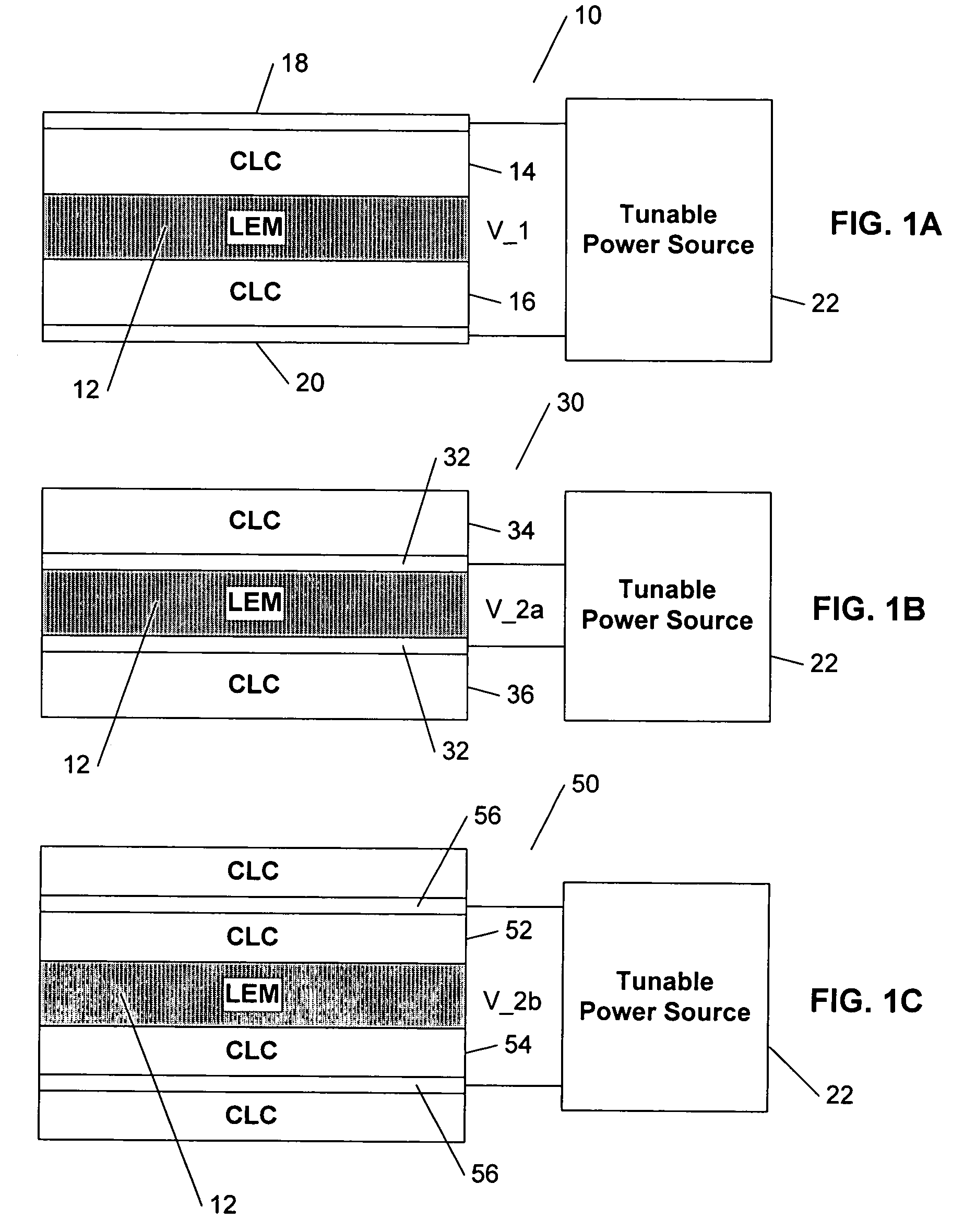Thin-film large-area coherent light source, filter and amplifier apparatus and method
a large-area coherent, thin-film technology, applied in the field of large-area, thin-film laser sources, can solve the problems of light sources, leds do not provide the performance needed for certain applications, and manufacture of vcsels requires sophisticated and expensive microfabrication, and achieves excellent efficient wide-area coherent lasing medium, facilitate heat extraction and high-power operation, and stable coherence area of the resulting lasing beam.
- Summary
- Abstract
- Description
- Claims
- Application Information
AI Technical Summary
Benefits of technology
Problems solved by technology
Method used
Image
Examples
first embodiment
[0054]Referring initially to FIG. 1A, in the present invention, a wide-area coherent chiral laser 10 includes an active light-emitting material 12 for producing gain, such as a light-emitting diode (e.g. a GaAs diode), sandwiched between an upper cholesteric liquid crystal (“CLC”) layer 14 and a lower CLC layer 16. The light-emitting material 12 may include, but is not limited to: laser dyes, rare earth elements, conjugated polymers or any medium in which electron-hole recombination occurs in the active material. As noted above, the CLC layers 14 and 16 may be composed from any chiral substance capable of transmitting light.
[0055]A first electrode 18 is connected to the upper CLC layer 14 and a second electrode 20 is connected to the lower CLC layer 20. Both electrodes 18 and 20 are connected to an external electrical power source 22. The tunable power source 22 may be any tunable electrical current source capable of providing charge current between electrodes connected thereto. Opt...
second embodiment
[0059]Referring now to FIG. 1B, the invention is shown as a chiral laser 30. The chiral laser 30 includes an active light-emitting material 12 for producing gain, sandwiched between an upper CLC layer 34 and a lower CLC layer 36. As noted above, the CLC layers 34 and 36 may be composed from any chiral substance capable of transmitting light.
[0060]A first electrode 32 is positioned between the upper CLC layer 34 and the light-emitting material 12, while a second electrode 32 is positioned between the light-emitting material 12 and the lower CLC layer 36. Both electrodes 32 are connected to the external electrical power source 22. When a voltage V_2a is applied between electrodes 32 by the power source 22, a charge current passes through the light-emitting material 12, exciting it and causing spontaneous and stimulated emission of electromagnetic radiation that results in polarized lasing at a predefined lasing wavelength. Lasing occurs in a direction perpendicular to the CLC layers 3...
third embodiment
[0062]Referring now to FIG. 1C, the present invention is shown as a chiral laser 50. The chiral laser 50 includes an upper CLC layer 52, a light-emitting material layer 12, a lower CLC layer 54, a first electrode 56 embedded within the upper CLC layer 52 and a second electrode 56 embedded within the lower CLC layer 54. Both electrodes are connected to the power source 22. The chiral laser 50 operates substantially in a similar manner to the chiral laser 30 except that the electrodes 56 need not be as transparent as electrodes 32, and the CLC layers 52 and 54 must be conductive. The voltage V_2b applied by the power source 22 is between V_1 and V_2a. Thus, the chiral laser 50 is less sensitive to the transparency of the electrodes than the chiral laser 30, but requires a higher voltage and more complex fabrication techniques.
PUM
| Property | Measurement | Unit |
|---|---|---|
| thickness | aaaaa | aaaaa |
| refractive index | aaaaa | aaaaa |
| frequency | aaaaa | aaaaa |
Abstract
Description
Claims
Application Information
 Login to View More
Login to View More - R&D
- Intellectual Property
- Life Sciences
- Materials
- Tech Scout
- Unparalleled Data Quality
- Higher Quality Content
- 60% Fewer Hallucinations
Browse by: Latest US Patents, China's latest patents, Technical Efficacy Thesaurus, Application Domain, Technology Topic, Popular Technical Reports.
© 2025 PatSnap. All rights reserved.Legal|Privacy policy|Modern Slavery Act Transparency Statement|Sitemap|About US| Contact US: help@patsnap.com



